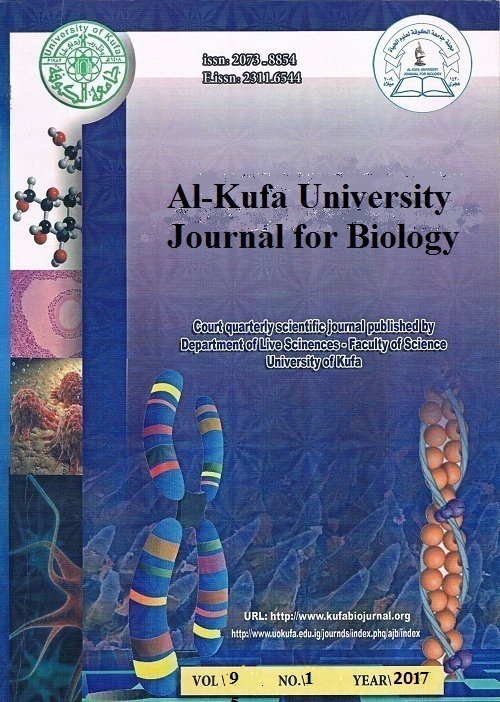Detection of Gene Involved in Biofilm Formation in Methecillin Resistance Staphylococcus aureus and Staphylococcus lentus and Effect of Camphor extract on These Genes
DOI:
https://doi.org/10.36320/ajb/v9.i1.8026Keywords:
camphor, biofilm ,methicillin ,Staphylococcus aureus , Staphylococcus lentus.icaA,icaD.Abstract
This research aimed to investigate the antibacterial activity of Camphor extract ,against biofilm formation of clinical isolates Staphylococcus aureus and Staphylococcus lentus .by detecting the presence and absence of virulence genes that responsible for the biofilm formation after treatment with Camphor extract. .thirty isolates were diagnosed initially as Staphylococci then selected five isolates depending on resistance to different type of antibiotics as virulence .After that the isolates test by VITEK-2compact system (ID and AST) to confirm the species of Staphylococci .The diagnostic result showed that three isolates belong to Staphylococcus aureus and two to Staphylococcus lentus. Investigation of the ability of camphor oil to inhibit the growth of bacteria using diffusion method in Muller Hinton agar ,the results showed the effect of camphor oil to prevent biofilm formation on both bacterial species with concentration (0.1 g/ml ).Downloads
References
Al-Snafi, A. E. (2016). Medicinal plants with antimicrobial activities (part 2):Plant based review. Scholars Academic J. Phar, 5(6), 208-239. DOI: https://doi.org/10.21276/sajp.2016.5.6.2
Siramon, p.; Ohtani,Y. and Ichiura, H.(2013). Chemical composition and antifungal property of Eucalyptus camaldulensis leaf oils from Thailand. Rec. Nat. Prod. 7(1) : 49-53.
Arciola, C.R.; Campoccia, D.; Ravaioli, S and Montanaro, L.(2015). Polysaccharide intercellular adhesin in biofilm: structural and regulatory aspects. Frontiers in Cellular and Infection Micro.;5:1–10. DOI: https://doi.org/10.3389/fcimb.2015.00007
Flemming, H. C.; Wingender, J.; Szewzyk, U.; Steinberg, P.; Rice, S. A and Kjelleberg, S. (2016). Biofilms: an emergent form of bacterial life. Nature Reviews Microbiology, 14(9), 563-575. DOI: https://doi.org/10.1038/nrmicro.2016.94
Namasivayam, S.K.R. and B. Avimanyu, (2011). Silver nanoparticle synthesis from Lecanicillium lecanii and evalutionary treatment on cotton fabrics by measuring their improved antibacterial activity with antibacterial antibiotics against Staphylococcus aureus (ATCC 29213) and Escherichia coli (ATCC 25922) strains. Int. J. Pharm. Pharmaceut. Sci., 4: 190-195
. Greenwood, D. (2012). Medical Microbiology: A Guide to Microbial Infections: Pathogenesis, Immunity, Laboratory Diagnosis and Control.30rdedNew York: Churchill Livingstone .
Zuccarini.p.(2009).Camphor:risks and benefits of a widely usd natural product .J.appl.sci.environ.m(2).69-74. DOI: https://doi.org/10.4314/jasem.v13i2.55317
Zinedine, A and Faid, M. (2007). Isolation and characterization of strains of Bifidobacteria with probiotic proprieties in vitro. World J.Dairy and Food Scien, 2(1), 28-34.
Klingenberg,C; Sundsfjord,A; Rønnestad,A; Mikalsen, J; Gaustad,P & Flaegstad,T(2004). Phenotypic and genotypic aminoglycoside resistance in blood culture isolates of coagulase-negative staphylococci from a single neonatal intensive care unit, 1989– 2000.J. Antimicrob.Chemother. 54: 889–896. DOI: https://doi.org/10.1093/jac/dkh453
Nourbakhsh.f.,and Namvar.E,.(2016). Detection of genes involved in biofilm formation in Staphylococcus aureus isolates.GMS.Hygiene and infection control.Vol:11,issn2196-5226.
Namvar.E, Asghari. B, Ezzatifar. F, Azizi. G, Rastegar. A.(2013). Detection of genes involved in biofilm formation in Staphylococcus aureus isolates.hyg.and infection .control.Vol:8(1),2196-5226.
Moussa I,M& Shibl, A,M .( 2009).Molecular characterization of methicillin-resistant staphylococcus aureus recovered from outpatient clinics in riyadh, saudi arabia. Saudi. Med. J . 30 (5):612-617.
Caiazza, N.C.; and G.A. O’Toole.( 2003 )..Alpha-Toxin Is Required for Biofilm Formation by Staphylococcus aureus. J. Bacteriol.185(10):3214-3217. DOI: https://doi.org/10.1128/JB.185.10.3214-3217.2003
Koneman, E. W.; Winn, W. C.; Allen, S. D.; Procop, G. W.; Schreckenberger, P. .; Janda, W. M. ; Woods, G. L. (2006). Koneman’s Color Atlas and Textbook of Diagnostic Microbiology. 6th ed., Lippincott Williams and Wilkins. U.S.A, pp. 211-269.
Gruenwald,J., Brendler,T., and Jaenicke,C.(2000): PDR for herbal medicines. Medical Economics Company, Inc.
Heuck,C.C;Piot,P.& Engback,K (1991).Basic Laboratory Procedures in Clinical Bacterology.WHO library Cataloguing in Publication. pp.69-70.
Chung PY, Toh YS.(2014). Anti-biofilm agents: recent breakthrough against multi-drug resistant Staphylococcus aureus. Pathog Vol:70(3):231-9. DOI: https://doi.org/10.1111/2049-632X.12141
Downloads
Published
How to Cite
Issue
Section
License
Copyright (c) 2019 Roaa Mohammed Hussein AL Kinani, Siham Jasim AL Kaabi

This work is licensed under a Creative Commons Attribution 4.0 International License.
which allows users to copy, create extracts, abstracts, and new works from the Article, alter and revise the Article, and make commercial use of the Article (including reuse and/or resale of the Article by commercial entities), provided the user gives appropriate credit (with a link to the formal publication through the relevant DOI), provides a link to the license, indicates if changes were made and the licensor is not represented as endorsing the use made of the work.












